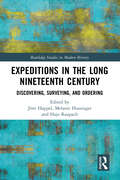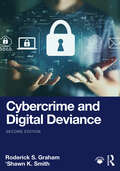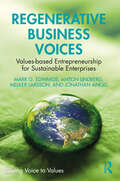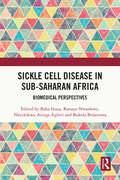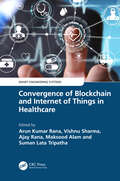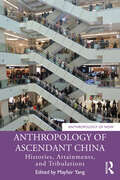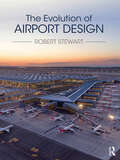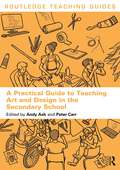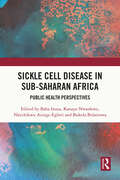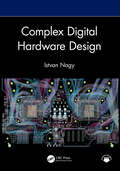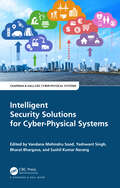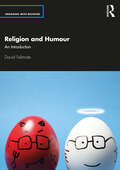- Table View
- List View
Expeditions in the Long Nineteenth Century: Discovering, Surveying, and Ordering (Routledge Studies in Modern History)
by Jörn Happel Melanie Hussinger Hajo RaupachThis book examines the processes of scientific, cultural, political, technical, colonial and violent appropriation during the 19th century. The 19th century was the century of world travel. The earth was explored, surveyed, described, illustrated, and categorized. Travelogues became world bestsellers. Modern technology accompanied the travelers and adventurers: clocks, a postal and telegraph system, surveying equipment, and cameras. The world grew together faster and faster. Previously unknown places became better known: the highest peaks, the coldest spots, the hottest deserts, and the most remote cities. Knowledge about the white spots of the earth was systematically collected. Those who made a name for themselves in the 19th century are still read today. Alexander von Humboldt or Charles Darwin made the epoch a scientific heyday. Ida Pfeiffer or Isabelle Bird (Bishop) traveled to distant continents and took their readers at home on insightful journeys. Hermann Vámbéry or Sir Richard Burton got to know the most remote languages and regions. There are countless travel reports about a fascinating century, which, with surveying and exploration, also brought colonial conquest and exploitation into the world. In ten individual studies, the authors explore travelers from all over the world and analyze their successes. The unifying element of all the studies is the experience of distance and its communication by means of travelogues to the armchair travelers who have stayed at home.This volume will be of value to students and scholars both interested in modern history, social and cultural history, and the history of science and technology.
Cybercrime and Digital Deviance
by Roderick S. Graham 'Shawn K. SmithCybercrime and Digital Deviance, Second Edition, combines insights from sociology, criminology, psychology, and cybersecurity to explore cybercrimes such as hacking, identity theft, and romance scams, along with forms of digital deviance such as pornography addiction, trolling, and “canceling” people for perceived violations of norms.Other issues are explored including cybercrime investigations, nation-state cybercrime, the use of algorithms in policing, cybervictimization, and expanded discussion of the theories used to explain cybercrime. Graham and Smith conceptualize the online space as a distinct environment for social interaction, framing their work with assumptions informed by their respective work in urban sociology and spatial criminology, and offering an engaging entry point for understanding what may appear to be a technologically complex course of study. The authors apply a modified version of a typology developed by David Wall: cybertrespass, cyberfraud, cyberviolence, and cyberpornography. This typology is simple enough for students just beginning their inquiry into cybercrime, while its use of legal categories of trespassing, fraud, violent crimes against persons, and moral transgressions provides a solid foundation for deeper study. In this edition each chapter includes a new “Current Events and Critical Thinking” section, using concepts from the chapter to explore a specific event or topic like the effect of disinformation on social cohesion and politics.Taken together, Graham and Smith’s application of a digital environment and Wall’s cybercrime typology makes this an ideal upper-level text for students in sociology and criminal justice. It is also an ideal introductory text for students within the emerging disciplines of cybercrime and cybersecurity.
Regenerative Business Voices: Values-based Entrepreneurship for Sustainable Enterprises (Giving Voice to Values)
by Mark G. Edwards Anton Lindberg Melker Larsson Jonathan AngelThis is a book about the future of sustainability. Regenerative Business Voices: Values-based Entrepreneurship for Sustainable Enterprises tells the stories of four regenerative organizations and the people who have founded them and guided them towards sustaining futures.Regenerative sustainability recognizes the urgency of transforming organizations to reverse the unsustainable pathways we are currently on. Regenerative businesses do not simply do less harm, or produce zero emissions, or optimize the efficient use of natural resources; they also restore and enhance well-being in social and ecological systems. The stories presented here are analyzed using the business ethics approach called Giving Voice to Values (GVV). Through the application of GVV principles, we uncover the processes involved in how regenerative businesses develop and function, and gain insights into how business leaders voice their deep convictions, overcome silencing rationalizations, normalize their execution of personal choice, discover deep purpose in their work, and draw on their personal histories to create new ways of doing business. We present and analyze these cases to understand how and why expressing values can be so crucial in developing sustainable businesses, and to provide practical examples of how individuals can generate enthusiasm, counter objections, gain allies, and prepare for and practice conversations that help them move forward.The book offers managers and sustainability consultants a new way of understanding some of the central dynamics involved in business ethics and organizational change for sustainability. It will be immensely valuable to educators, business students, and practitioners interested in sustainability, environmental business ethics, and corporate social responsibility topics.
Cybercrime and Digital Deviance
by Roderick S. Graham 'Shawn K. SmithCybercrime and Digital Deviance, Second Edition, combines insights from sociology, criminology, psychology, and cybersecurity to explore cybercrimes such as hacking, identity theft, and romance scams, along with forms of digital deviance such as pornography addiction, trolling, and “canceling” people for perceived violations of norms.Other issues are explored including cybercrime investigations, nation-state cybercrime, the use of algorithms in policing, cybervictimization, and expanded discussion of the theories used to explain cybercrime. Graham and Smith conceptualize the online space as a distinct environment for social interaction, framing their work with assumptions informed by their respective work in urban sociology and spatial criminology, and offering an engaging entry point for understanding what may appear to be a technologically complex course of study. The authors apply a modified version of a typology developed by David Wall: cybertrespass, cyberfraud, cyberviolence, and cyberpornography. This typology is simple enough for students just beginning their inquiry into cybercrime, while its use of legal categories of trespassing, fraud, violent crimes against persons, and moral transgressions provides a solid foundation for deeper study. In this edition each chapter includes a new “Current Events and Critical Thinking” section, using concepts from the chapter to explore a specific event or topic like the effect of disinformation on social cohesion and politics.Taken together, Graham and Smith’s application of a digital environment and Wall’s cybercrime typology makes this an ideal upper-level text for students in sociology and criminal justice. It is also an ideal introductory text for students within the emerging disciplines of cybercrime and cybersecurity.
Regenerative Business Voices: Values-based Entrepreneurship for Sustainable Enterprises (Giving Voice to Values)
by Mark G. Edwards Anton Lindberg Melker Larsson Jonathan AngelThis is a book about the future of sustainability. Regenerative Business Voices: Values-based Entrepreneurship for Sustainable Enterprises tells the stories of four regenerative organizations and the people who have founded them and guided them towards sustaining futures.Regenerative sustainability recognizes the urgency of transforming organizations to reverse the unsustainable pathways we are currently on. Regenerative businesses do not simply do less harm, or produce zero emissions, or optimize the efficient use of natural resources; they also restore and enhance well-being in social and ecological systems. The stories presented here are analyzed using the business ethics approach called Giving Voice to Values (GVV). Through the application of GVV principles, we uncover the processes involved in how regenerative businesses develop and function, and gain insights into how business leaders voice their deep convictions, overcome silencing rationalizations, normalize their execution of personal choice, discover deep purpose in their work, and draw on their personal histories to create new ways of doing business. We present and analyze these cases to understand how and why expressing values can be so crucial in developing sustainable businesses, and to provide practical examples of how individuals can generate enthusiasm, counter objections, gain allies, and prepare for and practice conversations that help them move forward.The book offers managers and sustainability consultants a new way of understanding some of the central dynamics involved in business ethics and organizational change for sustainability. It will be immensely valuable to educators, business students, and practitioners interested in sustainability, environmental business ethics, and corporate social responsibility topics.
Sickle Cell Disease in Sub-Saharan Africa: Biomedical Perspectives
This important collection provides an epidemiological perspective on the continuing scope of sickle cell disease (SCD) in sub-Saharan Africa, alongside the clinical attempts to provide comprehensive care in a resource-limited setting.The book moves from a clinical profile of SCD to screening for the disease and ongoing patient care. There are chapters on pain management, organ failure, infections and transfusions, as well as nutrition and neurocognitive complications. The book concludes with chapters on anti-sickness medication, cell transplantation and nursing care.The first in a two-volume set offering a multi-disciplinary perspective on SCD, this is a comprehensive resource that applies clinical knowledge to the practical challenges faced in sub-Saharan Africa. It will be important reading for medical students taking courses in haematology as well as those studying Public Health in sub-Saharan Africa. Practitioners in the region will also find it invaluable in developing their understanding of this pervasive disease.
Sickle Cell Disease in Sub-Saharan Africa: Biomedical Perspectives
by Baba Inusa Kanayo Nwankwo Nkechikwu Azinge-Egbiri Bukola BolarinwaThis important collection provides an epidemiological perspective on the continuing scope of sickle cell disease (SCD) in sub-Saharan Africa, alongside the clinical attempts to provide comprehensive care in a resource-limited setting.The book moves from a clinical profile of SCD to screening for the disease and ongoing patient care. There are chapters on pain management, organ failure, infections and transfusions, as well as nutrition and neurocognitive complications. The book concludes with chapters on anti-sickness medication, cell transplantation and nursing care.The first in a two-volume set offering a multi-disciplinary perspective on SCD, this is a comprehensive resource that applies clinical knowledge to the practical challenges faced in sub-Saharan Africa. It will be important reading for medical students taking courses in haematology as well as those studying Public Health in sub-Saharan Africa. Practitioners in the region will also find it invaluable in developing their understanding of this pervasive disease.
Convergence of Blockchain and Internet of Things in Healthcare (Smart Engineering Systems: Design and Applications)
The Internet of Things (IoT) and blockchain are two new technologies that combine elements in many ways. A system where the virtual and physical worlds interact is created by integrating pervasive computing, ubiquitous computing, communication technologies, sensing technologies, Internet Protocol, and embedded devices. A massive number of linked devices and vast amounts of data present new prospects for developing services that can directly benefit the economy, environment, society, and individual residents. Due to the size of IoT and insufficient data security, security breaches may have a huge impact and negative effects. IoT not only connects gadgets but also people and other entities, leaving every IoT component open to a wide variety of assaults. The implementation and application of IoT and blockchain technology in actual scientific, biomedical, and data applications are covered in this book. The book highlights important advancements in health science research and development by applying the distinctive capabilities inherent to distributed ledger systems. Each chapter describes the current uses of blockchain in real-world data collection, medicine development, device tracking, and more meaningful patient interaction. All of these are used to create opportunities for expanding health science research. This paradigm change is studied from the perspectives of pharmaceutical executives, biotechnology entrepreneurs, regulatory bodies, ethical review boards, and blockchain developers.Key Features: Provides a foundation for the implementation process of blockchain and IoT devices based on healthcare-related technology Image processing and IoT device researchers can correlate their work with other requirements of advanced technology in the healthcare domain Conveys the latest technology, including artificial intelligence and machine learning, in healthcare-related technology Useful for the researcher to explore new things like security, cryptography, and privacy in healthcare related technology Tailored for people who want to start in healthcare-related technology with blockchain and IoT This book is primarily for senior undergraduates, graduate students, and academic researchers in the fields of electrical engineering, electronics and communication engineering, computer science and engineering, and biomedical engineering.
Convergence of Blockchain and Internet of Things in Healthcare (Smart Engineering Systems: Design and Applications)
by Arun Kumar Rana, Vishnu Sharma, Ajay Rana, Maksud Alam and Suman Lata TripathiThe Internet of Things (IoT) and blockchain are two new technologies that combine elements in many ways. A system where the virtual and physical worlds interact is created by integrating pervasive computing, ubiquitous computing, communication technologies, sensing technologies, Internet Protocol, and embedded devices. A massive number of linked devices and vast amounts of data present new prospects for developing services that can directly benefit the economy, environment, society, and individual residents. Due to the size of IoT and insufficient data security, security breaches may have a huge impact and negative effects. IoT not only connects gadgets but also people and other entities, leaving every IoT component open to a wide variety of assaults. The implementation and application of IoT and blockchain technology in actual scientific, biomedical, and data applications are covered in this book. The book highlights important advancements in health science research and development by applying the distinctive capabilities inherent to distributed ledger systems. Each chapter describes the current uses of blockchain in real-world data collection, medicine development, device tracking, and more meaningful patient interaction. All of these are used to create opportunities for expanding health science research. This paradigm change is studied from the perspectives of pharmaceutical executives, biotechnology entrepreneurs, regulatory bodies, ethical review boards, and blockchain developers.Key Features: Provides a foundation for the implementation process of blockchain and IoT devices based on healthcare-related technology Image processing and IoT device researchers can correlate their work with other requirements of advanced technology in the healthcare domain Conveys the latest technology, including artificial intelligence and machine learning, in healthcare-related technology Useful for the researcher to explore new things like security, cryptography, and privacy in healthcare related technology Tailored for people who want to start in healthcare-related technology with blockchain and IoT This book is primarily for senior undergraduates, graduate students, and academic researchers in the fields of electrical engineering, electronics and communication engineering, computer science and engineering, and biomedical engineering.
Equipment and Components in the Oil and Gas Industry Volume 1: Equipment
by Karan SotoodehEquipment and Components in the Oil and Gas Industry Volume 1: Equipment provides an overview of the equipment used in the oil and gas industry, as well as various stages of the oil and gas industry, including geology, exploration, drilling, transportation, and refining. Using practical industry examples and an accessible approach, the book is a key reference point for those seeking to learn more about the industry.The equipment used in the oil and gas industry is wide ranging, from drilling equipment and wellhead equipment, such as casings, tubing, and wellhead Christmas trees, to equipment for the transportation of fluids and gases, such as pumps and compressors. The book presents a simplified method to choose the correct equipment for each task, as well as covering the selection of heat exchangers and storage tanks. Finally, this book covers turbines, motors, and other prime movers, alongside a flare system for disposing of unwanted or waste gases in oil and gas refineries and petrochemical plants.This book will be of interest to mechanical and chemical engineers working in the oil and gas industry.
Equipment and Components in the Oil and Gas Industry Volume 1: Equipment
by Karan SotoodehEquipment and Components in the Oil and Gas Industry Volume 1: Equipment provides an overview of the equipment used in the oil and gas industry, as well as various stages of the oil and gas industry, including geology, exploration, drilling, transportation, and refining. Using practical industry examples and an accessible approach, the book is a key reference point for those seeking to learn more about the industry.The equipment used in the oil and gas industry is wide ranging, from drilling equipment and wellhead equipment, such as casings, tubing, and wellhead Christmas trees, to equipment for the transportation of fluids and gases, such as pumps and compressors. The book presents a simplified method to choose the correct equipment for each task, as well as covering the selection of heat exchangers and storage tanks. Finally, this book covers turbines, motors, and other prime movers, alongside a flare system for disposing of unwanted or waste gases in oil and gas refineries and petrochemical plants.This book will be of interest to mechanical and chemical engineers working in the oil and gas industry.
Anthropology of Ascendant China: Histories, Attainments, and Tribulations (Anthropology of Now)
This volume represents the latest research in cultural anthropology on an ascendant and globalizing China, covering the many different dimensions of China’s ascendancy both within China itself and beyond.It focuses not only on the real and perceived successes of China in the past four decades, but also on the difficulties, tensions, and dangers that have emerged as a result of rapid economic development: class polarization, state expansion, psychological distress, and environmental degradation. Including contributions by some of the most well-known cultural anthropologists of China, as well as rising innovative younger scholars, this book documents and analyzes China’s multifaceted transformations in the modern era—both within Chinese society and in Chinese relations with the outside world. It features the unique perspective of anthropology, with its on-the-ground deep cultural immersion through long-term fieldwork, coupled with a macrolevel global perspective, a strong historical perspective, and theoretically engaged analyses to present a balanced account of China’s ascendancy.Anthropology of Ascendant China: Histories, Attainments, and Tribulations is suitable for students and scholars in Anthropology, Sociology, History, Political Science, and East Asian Studies, as well as those working on contemporary Chinese society and culture more broadly.
Anthropology of Ascendant China: Histories, Attainments, and Tribulations (Anthropology of Now)
by Mayfair YangThis volume represents the latest research in cultural anthropology on an ascendant and globalizing China, covering the many different dimensions of China’s ascendancy both within China itself and beyond.It focuses not only on the real and perceived successes of China in the past four decades, but also on the difficulties, tensions, and dangers that have emerged as a result of rapid economic development: class polarization, state expansion, psychological distress, and environmental degradation. Including contributions by some of the most well-known cultural anthropologists of China, as well as rising innovative younger scholars, this book documents and analyzes China’s multifaceted transformations in the modern era—both within Chinese society and in Chinese relations with the outside world. It features the unique perspective of anthropology, with its on-the-ground deep cultural immersion through long-term fieldwork, coupled with a macrolevel global perspective, a strong historical perspective, and theoretically engaged analyses to present a balanced account of China’s ascendancy.Anthropology of Ascendant China: Histories, Attainments, and Tribulations is suitable for students and scholars in Anthropology, Sociology, History, Political Science, and East Asian Studies, as well as those working on contemporary Chinese society and culture more broadly.
The Evolution of Airport Design
by Robert StewartThis is the first book to comprehensively cover the evolution of airport design, from the start of commercial aviation in 1919 to the present day. Many books have been written about airport design at a particular moment in history, but none have rigorously considered why, where, when and how the ideas we now take for granted originated.This book traces the history of airport design considering the philosophies adopted by designers, the functional layouts they have developed and the resultant form of the airport through a series of 40 case studies divided into 7 eras of approximately 20 years each. The themes include: The philosophies underpinning airport design The evolution of design responses How airports have avoided obsolescence Identification of the key turning points The evolution of master plans and terminal concepts in response to increasing traffic volumes The future of airports in terms of environmental sustainability and the Covid-19 hiatus The case studies are international, covering the USA, Germany, the UK, France, the Netherlands, Singapore, Saudi Arabia, Japan, Hong Kong, Malaysia, South Korea, Thailand, Spain, United Arab Emirates, China, Turkey, Mexico, Australia and Poland. They are illustrated with full colour, many of which have not been published before and form part of an incredible graphic package. This book is essential reading for architects, engineers, planners and environmentalists alike.
A Practical Guide to Teaching Art and Design in the Secondary School (Routledge Teaching Guides)
A Practical Guide to Teaching Art and Design in the Secondary School bridges the gap between key themes in Art and Design education theory, professional practice and the classroom. This practical and accessible book introduces methods for the delivery of engaging Art and Design lessons that safely and meaningfully address the current key issues in the subject.Each chapter includes tasks to support trainee and early career teachers in implementing, reviewing and adapting their teaching. Chapters cover a range of core approaches to the curriculum such as powerful knowledge for the Art and Design teacher, the place of Art History in the curriculum and critical thinking in Art and Design learning. In addition, emerging cultural and political issues (such as decolonising the Art and Design curriculum, gender and sexuality, anti-ablism, sustainability and well-being) are explored in ways designed to guide teachers towards applying their own unique teaching style.Linking directly to the planning and delivery of the subject in Key Stages 3, 4 and 5, the book is divided into three sections: Imaginative Curiosity for the Art and Design Teacher Epistemological Curiosity for Teachers and Learners Critical Curiosity in the Art and Design Classroom Designed to be used independently or alongside the essential textbook Learning to Teach Art and Design in the Secondary School, this book is packed with practical strategies, teaching ideas and activities in every chapter. The book provides everything trainee and early career teachers need to reflect on and develop their teaching practice, helping them to plan lessons across the subject in a variety of teaching situations.
The Evolution of Airport Design
by Robert StewartThis is the first book to comprehensively cover the evolution of airport design, from the start of commercial aviation in 1919 to the present day. Many books have been written about airport design at a particular moment in history, but none have rigorously considered why, where, when and how the ideas we now take for granted originated.This book traces the history of airport design considering the philosophies adopted by designers, the functional layouts they have developed and the resultant form of the airport through a series of 40 case studies divided into 7 eras of approximately 20 years each. The themes include: The philosophies underpinning airport design The evolution of design responses How airports have avoided obsolescence Identification of the key turning points The evolution of master plans and terminal concepts in response to increasing traffic volumes The future of airports in terms of environmental sustainability and the Covid-19 hiatus The case studies are international, covering the USA, Germany, the UK, France, the Netherlands, Singapore, Saudi Arabia, Japan, Hong Kong, Malaysia, South Korea, Thailand, Spain, United Arab Emirates, China, Turkey, Mexico, Australia and Poland. They are illustrated with full colour, many of which have not been published before and form part of an incredible graphic package. This book is essential reading for architects, engineers, planners and environmentalists alike.
A Practical Guide to Teaching Art and Design in the Secondary School (Routledge Teaching Guides)
by Andy Ash Peter CarrA Practical Guide to Teaching Art and Design in the Secondary School bridges the gap between key themes in Art and Design education theory, professional practice and the classroom. This practical and accessible book introduces methods for the delivery of engaging Art and Design lessons that safely and meaningfully address the current key issues in the subject.Each chapter includes tasks to support trainee and early career teachers in implementing, reviewing and adapting their teaching. Chapters cover a range of core approaches to the curriculum such as powerful knowledge for the Art and Design teacher, the place of Art History in the curriculum and critical thinking in Art and Design learning. In addition, emerging cultural and political issues (such as decolonising the Art and Design curriculum, gender and sexuality, anti-ablism, sustainability and well-being) are explored in ways designed to guide teachers towards applying their own unique teaching style.Linking directly to the planning and delivery of the subject in Key Stages 3, 4 and 5, the book is divided into three sections: Imaginative Curiosity for the Art and Design Teacher Epistemological Curiosity for Teachers and Learners Critical Curiosity in the Art and Design Classroom Designed to be used independently or alongside the essential textbook Learning to Teach Art and Design in the Secondary School, this book is packed with practical strategies, teaching ideas and activities in every chapter. The book provides everything trainee and early career teachers need to reflect on and develop their teaching practice, helping them to plan lessons across the subject in a variety of teaching situations.
Sickle Cell Disease in Sub-Saharan Africa: Public Health Perspectives
by Baba Inusa Kanayo Nwankwo Nkechikwu Azinge-Egbiri Bukola BolarinwaThis fascinating collection examines the socio-economic factors that impact the well-being of patients with sickle cell disease (SCD) in Sub-Saharan Africa and the critical importance of patient advocacy in the region.The book looks at a number of key issues, including the social determinants that influence the spread of the disease, the quality of life of children with SCD, the impact of stigma and the broader psychosocial burden of such a prevalent condition. There are also chapters on policy and Public Health management, including collaborations with non-governmental organisations (NGOs) and global partners.The second in a two-volume set offering a multi-disciplinary perspective on SCD, this insightful collection highlights many of the hidden issues faced across the region. It will be important reading for students of both Public Health and Medicine, as well as practitioners working for governments or NGOs.
Sickle Cell Disease in Sub-Saharan Africa: Public Health Perspectives
by Baba Inusa Kanayo Nwankwo Nkechikwu Azinge-Egbiri Bukola BolarinwaThis fascinating collection examines the socio-economic factors that impact the well-being of patients with sickle cell disease (SCD) in Sub-Saharan Africa and the critical importance of patient advocacy in the region.The book looks at a number of key issues, including the social determinants that influence the spread of the disease, the quality of life of children with SCD, the impact of stigma and the broader psychosocial burden of such a prevalent condition. There are also chapters on policy and Public Health management, including collaborations with non-governmental organisations (NGOs) and global partners.The second in a two-volume set offering a multi-disciplinary perspective on SCD, this insightful collection highlights many of the hidden issues faced across the region. It will be important reading for students of both Public Health and Medicine, as well as practitioners working for governments or NGOs.
Complex Digital Hardware Design
by Istvan NagyThis book is about how to design the most complex types of digital circuit boards used inside servers, routers and other equipment, from high-level system architecture down to the low-level signal integrity concepts. It explains common structures and subsystems that can be expanded into new designs in different markets.The book is targeted at all levels of hardware engineers. There are shorter, lower-level introductions to every topic, while the book also takes the reader all they way to the most complex and most advanced topics of digital circuit design, layout design, analysis, and hardware architecture.
Complex Digital Hardware Design
by Istvan NagyThis book is about how to design the most complex types of digital circuit boards used inside servers, routers and other equipment, from high-level system architecture down to the low-level signal integrity concepts. It explains common structures and subsystems that can be expanded into new designs in different markets.The book is targeted at all levels of hardware engineers. There are shorter, lower-level introductions to every topic, while the book also takes the reader all they way to the most complex and most advanced topics of digital circuit design, layout design, analysis, and hardware architecture.
Intelligent Security Solutions for Cyber-Physical Systems (Chapman & Hall/CRC Cyber-Physical Systems)
by Vandana Mohindru Sood Yashwant Singh Bharat Bhargava Sushil Kumar NarangA cyber-physical system (CPS) is a computer system in which a mechanism is controlled or monitored by computer-based algorithms and involves transdisciplinary approaches, merging theories of cybernetics, mechatronics, design, and process science. This text mainly concentrates on offering a foundational theoretical underpinning, and a comprehensive and coherent review of intelligent security solutions for cyber-physical systems. Features: • Provides an overview of cyber-physical systems (CPSs) along with security concepts like attack detection methods, cyber-physical systems failures, and risk identification and management. • Showcases cyber-physical systems (CPSs) security solutions, lightweight cryptographic solutions, and CPS forensics, etc. • Emphasizes machine learning methods for behavior-based intrusion detection in cyber-physical systems (CPSs), resilient machine learning for networked CPS, fog computing industrial CPS, etc. • Elaborates classification of network abnormalities in Internet of Things-based cyber-physical systems (CPSs) using deep learning. • Includes case studies and applications in the domain of smart grid systems, industrial control systems, smart manufacturing, social network and gaming, electric power grid and energy systems, etc.
Intelligent Security Solutions for Cyber-Physical Systems (Chapman & Hall/CRC Cyber-Physical Systems)
by Vandana Mohindru Sood Yashwant Singh Bharat Bhargava Sushil Kumar NarangA cyber-physical system (CPS) is a computer system in which a mechanism is controlled or monitored by computer-based algorithms and involves transdisciplinary approaches, merging theories of cybernetics, mechatronics, design, and process science. This text mainly concentrates on offering a foundational theoretical underpinning, and a comprehensive and coherent review of intelligent security solutions for cyber-physical systems. Features: • Provides an overview of cyber-physical systems (CPSs) along with security concepts like attack detection methods, cyber-physical systems failures, and risk identification and management. • Showcases cyber-physical systems (CPSs) security solutions, lightweight cryptographic solutions, and CPS forensics, etc. • Emphasizes machine learning methods for behavior-based intrusion detection in cyber-physical systems (CPSs), resilient machine learning for networked CPS, fog computing industrial CPS, etc. • Elaborates classification of network abnormalities in Internet of Things-based cyber-physical systems (CPSs) using deep learning. • Includes case studies and applications in the domain of smart grid systems, industrial control systems, smart manufacturing, social network and gaming, electric power grid and energy systems, etc.
Religion and Humour: An Introduction (Engaging with Religion)
by David FeltmateThis timely and lively introduction to exploring the intersection of religion and humour evaluates existing scholarship and methodologies within the field, arguing for a culturally critical approach to the study.Hinged on a qualitative sociological framework, this book asks questions about the construction, presentation, and purpose of humour in religious contexts. It is broken down by theoretical approach, with chapters covering: a “comparative religions” approach; a theological approach; how social sciences offer us useful tools for research; and a review of existing theoretical models. As the first volume to introduce the field of religion and humour, this engaging book is essential reading for students approaching the topic for the first time, and for anyone with an interest in related fields such as religion and popular culture and humour studies.
Religion and Humour: An Introduction (Engaging with Religion)
by David FeltmateThis timely and lively introduction to exploring the intersection of religion and humour evaluates existing scholarship and methodologies within the field, arguing for a culturally critical approach to the study.Hinged on a qualitative sociological framework, this book asks questions about the construction, presentation, and purpose of humour in religious contexts. It is broken down by theoretical approach, with chapters covering: a “comparative religions” approach; a theological approach; how social sciences offer us useful tools for research; and a review of existing theoretical models. As the first volume to introduce the field of religion and humour, this engaging book is essential reading for students approaching the topic for the first time, and for anyone with an interest in related fields such as religion and popular culture and humour studies.
